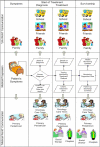Pediatric palliative care and eHealth opportunities for patient-centered care
- PMID: 21521596
- PMCID: PMC3703627
- DOI: 10.1016/j.amepre.2011.01.013
Pediatric palliative care and eHealth opportunities for patient-centered care
Abstract
Background: Pediatric palliative care currently faces many challenges including unnecessary pain from insufficiently personalized treatment, doctor-patient communication breakdowns, and a paucity of usable patient-centric information. Recent advances in informatics for consumer health through eHealth initiatives have the potential to bridge known communication gaps, but overall these technologies remain under-utilized in practice.
Purpose: This paper seeks to identify effective uses of existing and developing health information technology (HIT) to improve communications and care within the clinical setting.
Methods: A needs analysis was conducted by surveying seven pediatric oncology patients and their extended support network at the Lombardi Pediatric Clinic at Georgetown University Medical Center in May and June of 2010. Needs were mapped onto an existing inventory of emerging HIT technologies to assess what existing informatics solutions could effectively bridge these gaps.
Results: Through the patient interviews, a number of communication challenges and needs in pediatric palliative cancer care were identified from the interconnected group perspective surrounding each patient. These gaps mapped well, in most cases, to existing or emerging cyberinfrastructure. However, adoption and adaptation of appropriate technologies could improve, including for patient-provider communication, behavioral support, pain assessment, and education, all through integration within existing work flows.
Conclusions: This study provides a blueprint for more optimal use of HIT technologies, effectively utilizing HIT standards-based technology solutions to improve communication. This research aims to further stimulate the development and adoption of interoperable, standardized technologies and delivery of context-sensitive information to substantially improve the quality of care patients receive within pediatric palliative care clinics and other settings.
Copyright © 2011 American Journal of Preventive Medicine. All rights reserved.
Figures
References
-
- World Health Organization . National cancer control programmes : policies and managerial guidelines. 2nd ed. World Health Organization; Geneva, Switzerland: 2002.
-
- Adler NE, Page A, National Institue of Medicine (U.S.) Committee on Psychosocial Services to Cancer Patients / Families in a Community Setting . Cancer care for the whole patient : meeting psychosocial health needs. National Academies Press; Washington, D.C.: 2008. - PubMed
-
- Hewitt ME, Ganz PA, Institute of Medicine (U.S.) American Society of Clinical Oncology (U.S.) From cancer patient to cancer survivor : lost in transition : an American Society of Clinical Oncology and Institute of Medicine Symposium. National Academies Press; Washington, D.C.: 2006.
-
- Tercyak KP, Donze JR, Prahlad S, Mosher RB, Shad AT. Multiple behavioral risk factors among adolescent survivors of childhood cancer in the Survivor Health and Resilience Education (SHARE) program. Pediatr Blood Cancer. 2006 Nov;47(6):825–830. - PubMed
Publication types
MeSH terms
Grants and funding
LinkOut - more resources
Full Text Sources
Other Literature Sources
Medical



